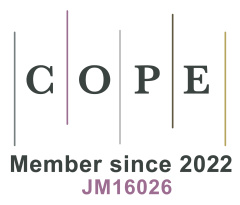A case of primary systemic amyloidosis with prominent hematemesis and biomechanical implications of amyloid deposition
Abstract
This article reviews a case of primary systemic amyloidosis characterized by vomiting blood. The patient was treated at the Affiliated Central Hospital of Shandong First Medical University for vomiting blood. Gastroscopy pathology showed amyloid deposition and restricted expression of plasma cell light chains, with elevated free light chains in hematuria. Bone marrow biopsy confirmed primary systemic amyloidosis. Amyloid deposition significantly altered tissue biomechanical properties, including increased stiffness and reduced elasticity in affected organs such as the gastrointestinal tract and heart, contributing to organ dysfunction. The patient received a chemotherapy regimen (D-CyBorD), achieving partial remission. However, irreversible multi-organ involvement persisted, underscoring the progressive nature of amyloid-induced biomechanical and functional damage. This study highlights the interplay between amyloid pathology, biomechanical tissue changes, and clinical outcomes, emphasizing the need for early diagnosis and multidisciplinary management.
References
1. Vaxman I, Gertz M. Recent Advances in the Diagnosis, Risk Stratification, and Management of Systemic Light-Chain Amyloidosis. Acta Haematologica. 2019; 141(2): 93-106. doi: 10.1159/000495455
2. Dvir K, Galarza-Fortuna GM, Willet A, et al. A Rare Case of Light Chain Amyloidosis of the Gastrointestinal Tract. Case Reports in Surgery. 2020; 2020: 1-4. doi: 10.1155/2020/1921805
3. Hegenbart U, Fuhr N, Huber L, et al. Two-Year Evaluation of the German Clinical Amyloidosis Registry. Blood. 2021; 138(Supplement 1): 3780-3780. doi: 10.1182/blood-2021-152713
4. Gertz MA. Immunoglobulin light chain amyloidosis: 2020 update on diagnosis, prognosis, and treatment. American Journal of Hematology. 2020; 95(7): 848-860. doi: 10.1002/ajh.25819
5. Ryšavá R. AL amyloidosis: advances in diagnostics and treatment. Nephrology Dialysis Transplantation. 2018; 34(9): 1460-1466. doi: 10.1093/ndt/gfy291
6. Zhou Y, Cui Y, Xu F. A case report of amyloidosis presenting as nephrotic syndrome complicated by giant gastric ulcer and upper gastrointestinal bleeding. Chinese Journal of Nephrology. 2021; 10(05): 296-299.
7. Liu Y, Wu T, Mao D, et al. Primary systemic amyloidosis involving multiple organs: a case report and literature review. Chinese Journal of Practical Diagnosis and Treatment. 2021; 35(10): 995-996.
8. Cohen OC, Wechalekar AD. Systemic amyloidosis: moving into the spotlight. Leukemia. 2020; 34(5): 1215-1228. doi: 10.1038/s41375-020-0802-4
9. Samuel N, Shah N. Clinical Characteristics of Light Chain Amyloidosis in an Underserved Patient Population. Blood. 2023; 142(Supplement 1): 6758-6758. doi: 10.1182/blood-2023-190458
10. Castiglione V, Franzini M, Aimo A, et al. Use of biomarkers to diagnose and manage cardiac amyloidosis. European Journal of Heart Failure. 2021; 23(2): 217-230. doi: 10.1002/ejhf.2113
11. Li X, Zhou J, Zhou B. The value of cardiac ultrasound in the diagnosis of myocardial amyloidosis. Imaging Research and Medical Application. 2020; 4(21): 224-225.
12. Kastritis E, Gavriatopoulou M, Roussou M, et al. Renal outcomes in patients with AL amyloidosis: Prognostic factors, renal response and the impact of therapy. American Journal of Hematology. 2017; 92(7): 632-639. doi: 10.1002/ajh.24738
13. Zhao L, Ren G, Guo J, et al. Clinical manifestations and prognosis of systemic light-chain amyloidosis involving the liver. Journal of Nephrology, Dialysis and Kidney Transplantation. 2019; 28(04): 318-23.
14. Khoor A, Colby TV. Amyloidosis of the Lung. Archives of Pathology & Laboratory Medicine. 2017; 141(2): 247-254. doi: 10.5858/arpa.2016-0102-ra
15. Radu Șerban M, Florentin SC, Alina CA. Pulmonary Amyloidoma: A Case Report and Brief Review of the Literature. Diagnostics. 2023; 13(22): 3411. doi: 10.3390/diagnostics13223411
16. Dwivedi T, Chavan R. Primary Systemic Amyloidosis: A Case Report. Annals of Pathology and Laboratory Medicine. 2016; 3(01).
17. Sen Oli S, Jha A, Karki A, et al. Primary Systemic Amyloidosis: A Case Report. Journal of Nepal Medical Association. 2023; 61(266): 822-824. doi: 10.31729/jnma.8297
18. Kumar S, Dispenzieri A, Lacy MQ, et al. Revised Prognostic Staging System for Light Chain Amyloidosis Incorporating Cardiac Biomarkers and Serum Free Light Chain Measurements. Journal of Clinical Oncology. 2012; 30(9): 989-995. doi: 10.1200/jco.2011.38.5724
19. Chiappini MG, Proietti E, Vaiarello V, et al. #2757 Clinical course and prognostic factors in amyloidosis. Nephrology Dialysis Transplantation. 2024; 39(Supplement_1). doi: 10.1093/ndt/gfae069.573
20. Sharpley FA, Giles HV, Manwani R, et al. Quantitative Immunoprecipitation Free Light Chain Mass Spectrometry (QIP-FLC-MS) Simplifies Monoclonal Protein Assessment and Provides Added Clinical Value in Systemic AL Amyloidosis. Blood. 2019; 134(Supplement_1): 4375-4375. doi: 10.1182/blood-2019-128175
21. Kastritis E, Palladini G, Minnema MC, et al. Daratumumab-Based Treatment for Immunoglobulin Light-Chain Amyloidosis. N Engl J Med. 2021; 385(1): 46-58.
22. Ueno A, Katoh N, Aramaki O, et al. Liver Transplantation Is a Potential Treatment Option for Systemic Light Chain Amyloidosis Patients with Dominant Hepatic Involvement: A Case Report and Analytical Review of the Literature. Internal Medicine. 2016; 55(12): 1585-1590. doi: 10.2169/internalmedicine.55.6675
23. Bravo PE, Fujikura K, Kijewski MF, et al. Relative Apical Sparing of Myocardial Longitudinal Strain Is Explained by Regional Differences in Total Amyloid Mass Rather Than the Proportion of Amyloid Deposits. JACC: Cardiovascular Imaging. 2019; 12(7): 1165-1173. doi: 10.1016/j.jcmg.2018.06.016
Copyright (c) 2025 Author(s)

This work is licensed under a Creative Commons Attribution 4.0 International License.
Copyright on all articles published in this journal is retained by the author(s), while the author(s) grant the publisher as the original publisher to publish the article.
Articles published in this journal are licensed under a Creative Commons Attribution 4.0 International, which means they can be shared, adapted and distributed provided that the original published version is cited.



 Submit a Paper
Submit a Paper
